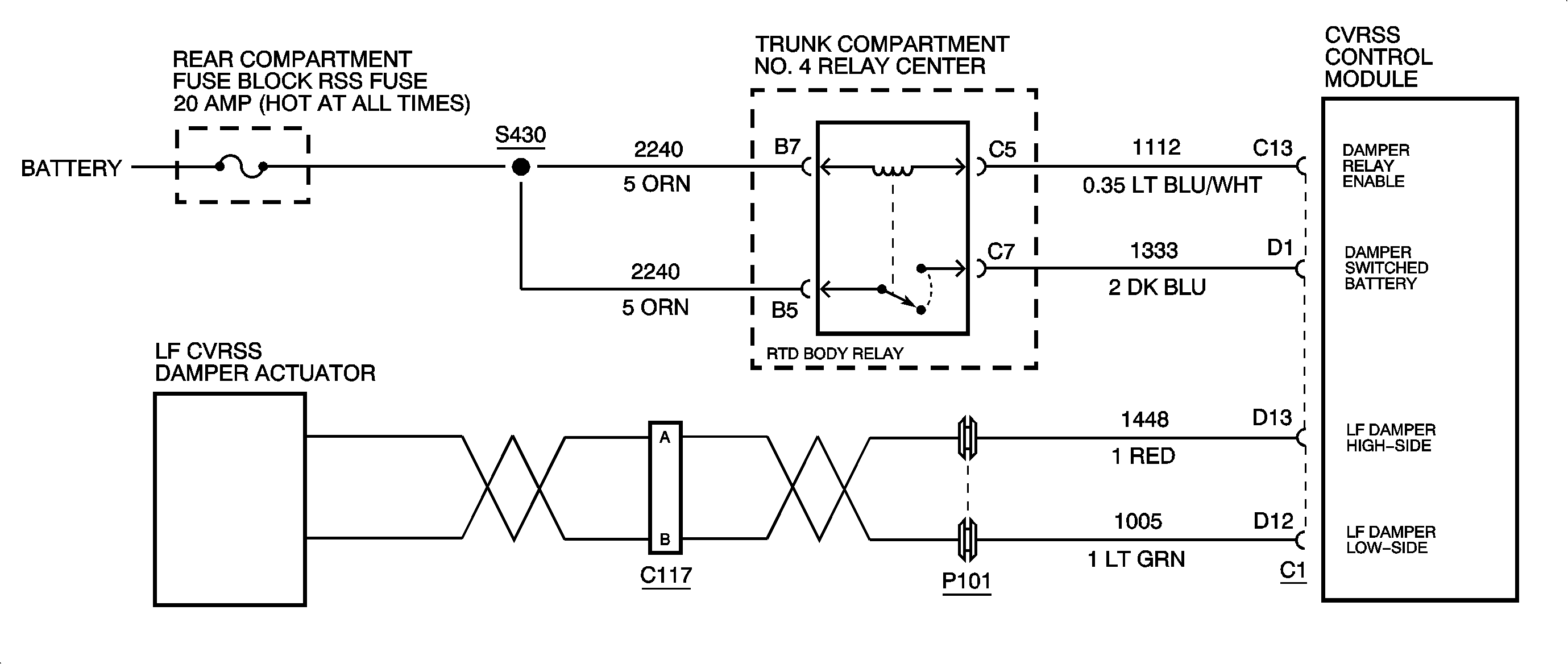
Circuit Description
The LF damper actuator is driven by the CVRSS control module via a method known as Pulse-Width Modulation (PWM). Battery voltage is PWMed (switched on and off) at a high frequency (2.0 kHz), thus controlling the amount of current delivered to the actuator. By controlling the amount of current to the actuator the CVRSS control module can then control the damping force in the damper. A higher level of damping force is achieved by providing correspondingly higher current levels, relating to higher percentages of PWM duty cycle.
The default damper state (with no battery voltage, and thus no current, provided to the attached actuator) is one that provides a minimum damping force.
Conditions for Setting the DTC
The DTC is set when the CVRSS control module measures a feedback voltage lower than a preset value during two consecutive OFF-state damper diagnostic test procedures.
The DTC is set when the CVRSS control module performs a test procedure on each damper actuator approximately every 16 seconds. During this test procedure the damper actuator is briefly energized (ON-state test) and de-energized (OFF-state test). If, twice consecutively, the feedback voltage during the OFF-state test is below the fault threshold, the corresponding DTC is set.
The DTC turns HISTORY when the CVRSS control module no longer senses a short circuit to ground condition on the damper low-side drive.
Action Taken When the DTC Sets
| • | The SERVICE RIDE CONTROL message will be displayed. |
| • | ALL the damper actuators will be disabled by commanding 0 % PWM duty cycle. |
| • | The damper high-side will be opened. |
| • | The vehicle speed will be limited. |
| • | The vehicle ride will be soft. |
Conditions for Clearing the MIL/DTC
| • | Use the scan tool. |
| • | Use the On-Board diagnostic CLEAR RSS CODES feature. |
Test Description
The number(s) below refer to the step number(s) on the diagnostic table.
Important: Intermittent connections in circuits 2240, 1112, or 998, or with the RTD Body Relay may cause this DTC to set. If this DTC is displayed as HISTORY, look for intermittents in circuits 2240, 1112, or 998, or the RTD Body Relay.
-
This step checks for a fault in the damper relay (RTD Body Relay) circuit.
-
This step checks for an internal open circuit condition in the actuator.
-
This step checks for short circuit to ground circuit condition in the actuator pigtail harness.
-
This step checks the CVRSS actuator harness (circuit 1113) for a short to ground condition with the actuator disconnected.
Important:
• Do not backprobe the sensor, actuators, or any sealed connectors. • When all the diagnostics and repairs are complete, clear the DTCs
and verify the operation.
Step | Action | Value(s) | Yes | No |
|---|---|---|---|---|
1 | Was the CVRSS System Check performed? | -- | Go to Step 2 | |
Is DTC C1786, C1787, or C1788 set (CURRENT or HISTORY)? | -- | Go to Step 3 | ||
Is the resistance value displayed on the voltmeter between 9.5 and 15.5 ohms? | 9.5-15.5 ohms | Go to Step 4 | Go to Step 12 | |
Check for continuity between pin B of the LF damper actuator connector (damper side) and ground. Is there continuity? | -- | Go to Step 9 | Go to Step 5 | |
Was a short circuit to ground condition found? | -- | Go to Step 6 | Go to Step 7 | |
6 | Repair the short circuit to ground condition in circuit 1113. Is the repair complete? | -- | -- | |
7 | Check for an open circuit condition in circuit 1107. Was an open circuit condition found? | -- | Go to Step 8 | Go to Step 9 |
8 | Repair the open circuit condition in circuit 1107. Is the repair complete? | -- | -- | |
9 | Check for an open circuit condition in circuit 1113. Was an open circuit condition found? | -- | Go to Step 10 | Go to Step 11 |
10 | Repair the open circuit condition in circuit 1113. Is the repair complete? | -- | -- | |
11 |
Is DTC C1711 or C1712 set? | -- | Go to Step 13 | |
12 | Replace the LF damper. Refer to Strut Assembly Replacement . Is the replacement complete? | -- | -- | |
13 |
Important: The controller must be calibrated. Is the CVRSS control module calibrated? | -- | -- |
